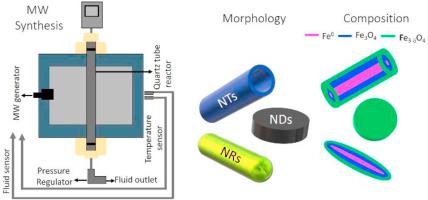当前位置:
X-MOL 学术
›
J. Alloys Compd.
›
论文详情
Our official English website, www.x-mol.net, welcomes your
feedback! (Note: you will need to create a separate account there.)
Tuning the shape, size, phase composition and stoichiometry of iron oxide nanoparticles: The role of phosphate anions
Journal of Alloys and Compounds ( IF 5.8 ) Pub Date : 2021-03-01 , DOI: 10.1016/j.jallcom.2020.156940 Gopal Niraula , Jose A.H. Coaquira , Fermin H. Aragon , Bianca M. Galeano Villar , Alexandre Mello , Flavio Garcia , Diego Muraca , Giorgio Zoppellaro , Jose M. Vargas , Surender K. Sharma
Journal of Alloys and Compounds ( IF 5.8 ) Pub Date : 2021-03-01 , DOI: 10.1016/j.jallcom.2020.156940 Gopal Niraula , Jose A.H. Coaquira , Fermin H. Aragon , Bianca M. Galeano Villar , Alexandre Mello , Flavio Garcia , Diego Muraca , Giorgio Zoppellaro , Jose M. Vargas , Surender K. Sharma

|
Abstract This work describes a microwave synthetic approach for the controlled assembly of α-Fe2O3 nanosystems with defined morphologies, such as hollow nanotubes (NTs), solid nanorods (NRs) and nanodisks (NDs). The morphological control is aided during the crystallization processes by using phosphate anions as key surfactants in solution. Furthermore, the thermal reduction under H2 atmosphere of these NTs, NRs and NDs α-Fe2O3 systems to the correspondent Fe3O4 nanomaterials preserved their initial morphologies. It was observed that the concentration of phosphate anions and volume of solvent had significant impact not only on controlling the shapes and sizes, but also phase composition and stoichiometry of the NTs, NRs and NDs nanoparticles. X-ray Rietveld refinement analysis of the NTs, NRs and NDs systems, after reduction in H2, revealed the presence of zero-valent iron (Fe0) in the final materials, with Fe0 fractions that decreased gradually in % from NTs (∼16%), NRs (∼11%) to NDs (∼0%) upon increasing amount of phosphate anions. Bulk magnetic susceptibility measurements showed clear alterations of the Verwey transition temperatures (TV) and the development of unusual magnetic phenomena, such as magnetic vortex states in NDs, which was subsequently verified by micro-magnetic simulations. From the combination of XRD analysis, bulk magnetic susceptibility and Mossbauer results, we provide herein a detailed mechanistic description of the chemical processes that gated the development of shape-controlled synthesis of NTs, NRs and NDs and give a detailed correlation between specific morphology and magneto-electronic behaviors.
中文翻译:

调整氧化铁纳米粒子的形状、尺寸、相组成和化学计量:磷酸根阴离子的作用
摘要 这项工作描述了一种微波合成方法,用于可控组装具有确定形态的 α-Fe2O3 纳米系统,例如中空纳米管 (NTs)、固体纳米棒 (NRs) 和纳米盘 (NDs)。通过使用磷酸盐阴离子作为溶液中的关键表面活性剂,在结晶过程中有助于形态控制。此外,这些 NTs、NRs 和 NDs α-Fe2O3 系统在 H2 气氛下热还原为相应的 Fe3O4 纳米材料,保留了它们的初始形态。据观察,磷酸根阴离子的浓度和溶剂的体积不仅对控制形状和尺寸有显着影响,而且对 NTs、NRs 和 NDs 纳米颗粒的相组成和化学计量也有显着影响。NTs、NRs 和 NDs 系统的 X 射线 Rietveld 细化分析,在减少 H2 后,揭示了最终材料中存在零价铁 (Fe0),随着磷酸盐含量的增加,Fe0 的比例从 NTs (~16%)、NRs (~11%) 到 NDs (~0%) 逐渐减少阴离子。体磁化率测量显示 Verwey 转变温度 (TV) 的明显变化和异常磁现象的发展,例如 ND 中的磁涡旋状态,随后通过微磁模拟进行了验证。结合 XRD 分析、体磁化率和 Mossbauer 结果,我们在此提供了对控制 NTs、NRs 和 NDs 形状控制合成发展的化学过程的详细机械描述,并给出了特定形态和磁导率之间的详细相关性-电子行为。
更新日期:2021-03-01
中文翻译:

调整氧化铁纳米粒子的形状、尺寸、相组成和化学计量:磷酸根阴离子的作用
摘要 这项工作描述了一种微波合成方法,用于可控组装具有确定形态的 α-Fe2O3 纳米系统,例如中空纳米管 (NTs)、固体纳米棒 (NRs) 和纳米盘 (NDs)。通过使用磷酸盐阴离子作为溶液中的关键表面活性剂,在结晶过程中有助于形态控制。此外,这些 NTs、NRs 和 NDs α-Fe2O3 系统在 H2 气氛下热还原为相应的 Fe3O4 纳米材料,保留了它们的初始形态。据观察,磷酸根阴离子的浓度和溶剂的体积不仅对控制形状和尺寸有显着影响,而且对 NTs、NRs 和 NDs 纳米颗粒的相组成和化学计量也有显着影响。NTs、NRs 和 NDs 系统的 X 射线 Rietveld 细化分析,在减少 H2 后,揭示了最终材料中存在零价铁 (Fe0),随着磷酸盐含量的增加,Fe0 的比例从 NTs (~16%)、NRs (~11%) 到 NDs (~0%) 逐渐减少阴离子。体磁化率测量显示 Verwey 转变温度 (TV) 的明显变化和异常磁现象的发展,例如 ND 中的磁涡旋状态,随后通过微磁模拟进行了验证。结合 XRD 分析、体磁化率和 Mossbauer 结果,我们在此提供了对控制 NTs、NRs 和 NDs 形状控制合成发展的化学过程的详细机械描述,并给出了特定形态和磁导率之间的详细相关性-电子行为。











































 京公网安备 11010802027423号
京公网安备 11010802027423号